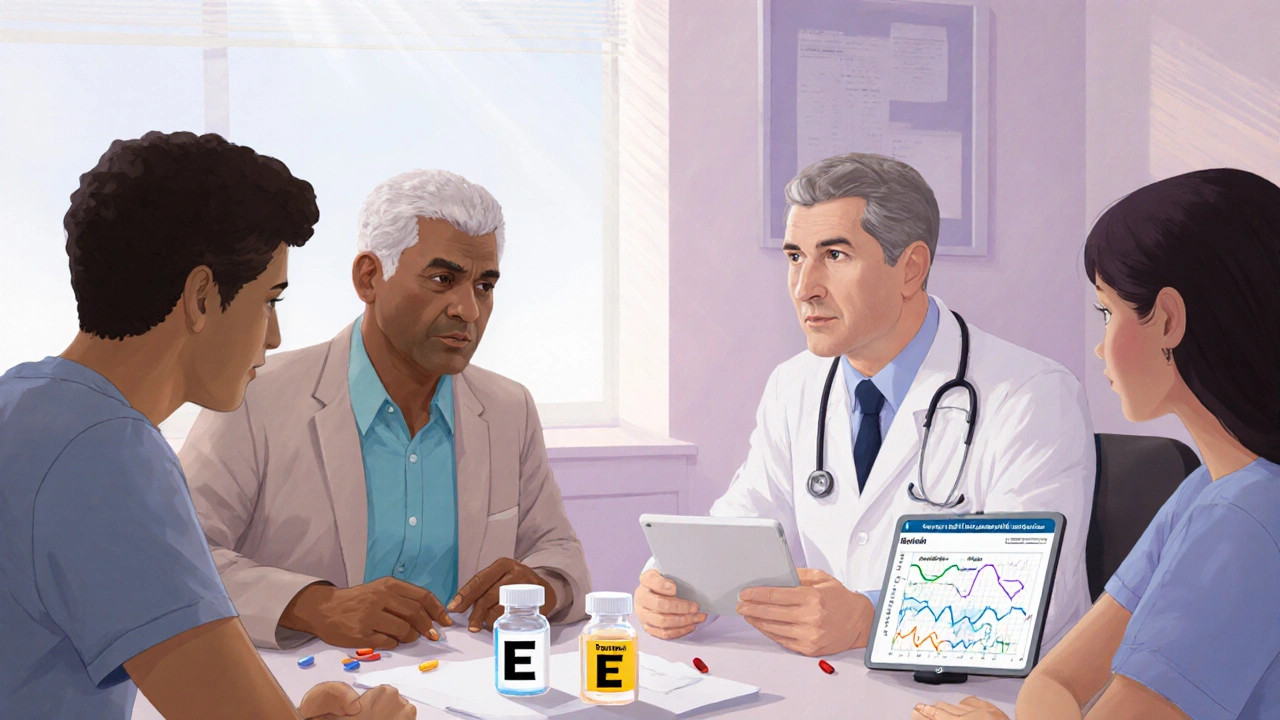Diabetes Medication Comparison Tool
Select your priorities to compare diabetes medications:
Key Takeaways
- Empagliflozin delivers strong heart‑failure protection that most alternatives lack.
- Other SGLT2 inhibitors (dapagliflozin, canagliflozin, ertugliflozin) share similar glucose‑lowering effects but differ in safety profiles.
- GLP‑1 agonists (liraglutide, semaglutide) offer superior weight loss but require injections.
- Metformin remains the cheapest first‑line option, though it doesn’t provide the cardiovascular benefits of empagliflozin.
- Cost varies widely by country and insurance; generic options can reduce out‑of‑pocket expense.
When it comes to managing type 2 diabetes, patients and clinicians face a maze of drug classes. Empagliflozin has risen to prominence because it not only lowers blood sugar but also cuts heart‑failure risk. This guide lines up empagliflozin against the most common alternatives, breaking down efficacy, safety, dosing, and price so you can decide what fits your health goals and budget.
What Is Empagliflozin?
Empagliflozin is an oral SGLT2 inhibitor that blocks glucose re‑absorption in the kidneys, causing excess sugar to be expelled in urine. Approved by the FDA in 2014, it quickly showed a mortality benefit in the EMPA‑REG OUTCOME trial, especially for patients with established cardiovascular disease.
How Do the Main Alternatives Work?
Below is a quick snapshot of the drug families you’ll most likely encounter.
- Dapagliflozin - another SGLT2 inhibitor, similar glucose‑lowering potency, FDA‑approved for chronic kidney disease.
- Canagliflozin - SGLT2 blocker noted for a higher risk of lower‑leg amputation, but strong renal protection.
- Ertugliflozin - newest SGLT2 inhibitor, modest weight loss, limited cardiovascular data.
- Liraglutide - a GLP‑1 receptor agonist injected daily, excellent for weight loss and heart‑failure reduction.
- Semaglutide - weekly GLP‑1 injection, provides the greatest A1C drop and weight loss among injectables.
- Metformin - the classic first‑line oral agent, inexpensive, works by reducing hepatic glucose production.
Side‑Effect Profiles at a Glance
Every medication carries trade‑offs. Understanding the most common adverse events helps you weigh the risk.
| Drug | Genitourinary Infections | Volume Depletion | Weight Change | Cardiovascular Benefit |
|---|---|---|---|---|
| Empagliflozin | 5‑10% | 3‑5% | -2kg (modest) | Yes (EMPA‑REG) |
| Dapagliflozin | 4‑9% | 2‑4% | -1.5kg | Yes (DECLARE‑TIMI 58) |
| Canagliflozin | 6‑12% | 4‑6% | -2kg | Yes (CANVAS) |
| Ertugliflozin | 5‑8% | 3‑5% | -1kg | Limited data |
| Liraglutide | Low | Low | -3‑5kg | Yes (LEADER) |
| Semaglutide | Low | Low | -5‑6kg | Yes (SUSTAIN‑6) |
| Metformin | Low | Low | Neutral | None |
Effectiveness: How Much Does Each Drug Lower A1C?
In head‑to‑head trials, SGLT2 inhibitors typically shave 0.5%-0.8% off the HbA1c level. Empagliflozin’s average reduction sits at about 0.7% when used as add‑on therapy.
- Dapagliflozin: 0.6%-0.9% reduction.
- Canagliflozin: 0.7%-1.0% reduction, slightly higher at max dose.
- Ertugliflozin: 0.5%-0.8% reduction.
- Liraglutide: 0.8%-1.2% reduction (injectable).
- Semaglutide: 1.0%-1.5% reduction - the strongest among approved agents.
- Metformin: 0.6%-1.0% reduction as monotherapy.
So, if you’re after the biggest A1C swing, a GLP‑1 agonist edges out the SGLT2 class, but empagliflozin still beats many older drugs and adds heart protection.
Cardiovascular and Renal Outcomes
Empagliflozin’s claim to fame is the 38% relative risk reduction in cardiovascular death seen in EMPA‑REG. Dapagliflozin and canagliflozin have also shown mortality benefits, but their data are slightly less robust. GLP‑1 agents like liraglutide and semaglutide carry cardiovascular safety evidence, with semaglutide reporting a 26% MACE (major adverse cardiovascular events) reduction.
Renal protection is another hot topic. Empagliflozin slows eGFR decline by roughly 30% in patients with chronic kidney disease, a benefit mirrored by dapagliflozin (CREDENCE trial). Canagliflozin also has renal data, but the amputation signal has limited its use in some guidelines.

Dosing Convenience and Administration
All SGLT2 inhibitors, including empagliflozin, are once‑daily oral tablets taken with or without food. Empagliflozin starts at 10mg and can be titrated to 25mg. Dapagliflozin is 5mg → 10mg; canagliflozin 100mg → 300mg; ertugliflozin 5mg → 15mg.
GLP‑1 agonists require injection: liraglutide is a daily pen, semaglutide a weekly pre‑filled syringe or oral tablet (Rybelsus). Metformin comes in immediate‑release (500mg twice daily) or extended‑release (500‑1000mg once daily).
Cost Landscape in 2025
Pricing fluctuates by country, insurance coverage, and whether a generic is available. Below is an approximate US out‑of‑pocket range for a 30‑day supply (no insurance).
- Empagliflozin (brand: Jardiance): $300‑$350.
- Dapagliflozin (brand: Farxiga): $280‑$330.
- Canagliflozin (brand: Invokana): $320‑$380.
- Ertugliflozin (brand: Steglatro): $300‑$360.
- Liraglutide (brand: Victoza): $800‑$950.
- Semaglutide (brand: Ozempic/Wegovy): $900‑$1,100.
- Metformin (generic): $4‑$12.
In Australia, the PBS subsidizes empagliflozin and dapagliflozin, bringing patient cost down to under $30 per month. Always check your local formulary; some plans favor one SGLT2 over another based on negotiated price.
Choosing the Right Agent: Decision Matrix
Think of medication selection as a checklist. Match your priority (cardio‑protection, weight loss, cost) against each drug’s strengths.
- Best for cardiovascular death reduction: Empagliflozin.
- Best for weight loss: Semaglutide (injectable) or Liraglutide.
- Best for chronic kidney disease: Dapagliflozin (CREDENCE data) or Empagliflozin.
- Best for low cost: Metformin, followed by generic empagliflozin (if available).
- Best for patients who dislike injections: Any SGLT2 inhibitor - all oral.
Practical Tips for Patients Starting Empagliflozin
- Stay hydrated - SGLT2 inhibitors increase urine output.
- Check for urinary tract infection symptoms early; treat promptly.
- Avoid initiating if you have uncontrolled urinary tract infection or active genital fungal infection.
- Monitor blood pressure; a drop of 3‑5mmHg is common.
- Discuss with your doctor if you have a history of ketoacidosis - rare but serious.
When Not to Use Empagliflozin
Contraindications include:
- Severe renal impairment (eGFR <30mL/min/1.73m²).
- Type 1 diabetes (risk of euglycemic ketoacidosis).
- Pregnancy or breastfeeding.
- Active bladder cancer (insufficient safety data).
Summary of How Empagliflozin Stands Up
Empagliflozin offers a rare blend of oral convenience, solid glucose control, and proven heart‑failure benefit. Its safety profile is comparable to other SGLT2 drugs, though you’ll see a slightly higher rate of genital mycotic infections. If cardiovascular protection tops your list, it’s hard to beat.
Frequently Asked Questions
Can I take empagliflozin with metformin?
Yes. The two drugs work via different mechanisms - metformin reduces liver glucose output, while empagliflozin forces excess glucose out through the kidneys. Combining them often yields a greater A1C drop without adding major side effects.
How quickly does empagliflozin start lowering blood sugar?
Blood glucose begins to fall within 24‑48hours after the first dose, with the full effect evident after about two weeks of consistent use.
Is empagliflozin safe for people with mild kidney disease?
Yes, as long as eGFR is above 45mL/min/1.73m². Below that, the drug’s glucose‑lowering ability wanes, and guidelines recommend dose reduction or discontinuation.
Why do I get more yeast infections on empagliflozin?
The drug increases glucose in the urine, creating a favorable environment for yeast and bacteria. Good hygiene, staying dry, and using over‑the‑counter antifungal powders can keep symptoms in check.
How does empagliflozin compare cost‑wise to semaglutide?
Empagliflozin is far cheaper - roughly $300 per month in the US versus $900‑$1,100 for semaglutide. Insurance can narrow the gap, but for most patients the oral SGLT2 inhibitor remains the more affordable cardio‑protective option.

Cherish Capps
September 30, 2025 AT 18:25Hey everyone, just wanted to flag that empagliflozin’s heart‑failure benefit can really shift the treatment plan for folks who also have cardiovascular disease. It’s an oral option so it’s easier than the injectables.
Amy Carpenetti
October 1, 2025 AT 02:53Considering the cost differences, the SGLT2 class often lands in the middle of the price range while still delivering solid A1C drops.
Paul Griffin
October 1, 2025 AT 12:36From a coaching perspective, pairing empagliflozin with lifestyle changes maximizes both glycemic control and cardiovascular protection. Encourage patients to stay hydrated and monitor for urinary symptoms.
Michael Tekely
October 1, 2025 AT 22:20The SGLT2 inhibition pathway offers a neat balance of glucose excretion and modest weight loss, and empagliflozin certainly leads the pack on CV outcomes. Just remember to watch volume status in the elderly. The drug’s once‑daily dosing fits well into most regimens.
Oscar Taveras
October 2, 2025 AT 08:03It is encouraging to see robust data supporting empagliflozin’s reduction in cardiovascular mortality; patients should feel optimistic about their prognosis 😊.
katie clark
October 2, 2025 AT 17:46One must acknowledge the nuanced pharmacoeconomic considerations that accompany SGLT2 inhibitors, particularly when juxtaposed against the generics of the metformin era.
Carissa Engle
October 3, 2025 AT 03:30Empagliflozin has carved out a distinct niche in the therapeutic armamentarium for type 2 diabetes, largely because of its cardiovascular mortality benefit, which was highlighted in the EMPA‑REG OUTCOME trial, and this data set a new benchmark for what we expect from glucose‑lowering agents, the drug’s mechanism of action as a selective SGLT2 inhibitor promotes glycosuria, leading to modest reductions in weight and blood pressure, which are ancillary advantages, the safety profile includes a higher incidence of genital mycotic infections and a modest risk of volume depletion, but these can be mitigated with patient education, the cost remains a barrier for many patients, especially in the United States where brand‑only pricing prevails, however, insurance formularies and patient assistance programs sometimes offset these expenses, clinicians often weigh empagliflozin against GLP‑1 agonists where weight loss is a priority, although the latter require injections, the oral convenience of empagliflozin is appealing for injection‑averse individuals, renal protective effects have also been documented, slowing eGFR decline in chronic kidney disease cohorts, this dual benefit of glycemic and renal outcomes is compelling, the drug is dosed once daily, starting at 10 mg and titrating to 25 mg, offering flexibility based on tolerability, it is contraindicated in patients with severe renal impairment, which underscores the importance of baseline eGFR assessment, overall, empagliflozin represents a well‑rounded option that addresses multiple metabolic and cardiovascular goals, yet its place in therapy must be individualized based on patient comorbidities, preferences, and financial considerations.
Lindsey Crowe
October 3, 2025 AT 07:40Wow, another pricey pill that promises the moon.
Dietra Jones
October 3, 2025 AT 16:00Just a heads‑up: if you’re on empagliflozin, keep an eye on your hydration levels-lots of folks forget and end up with dizziness.
Marcia Hayes
October 4, 2025 AT 01:43Great rundown! I love how easy it is to compare the meds side‑by‑side. Keep the info coming.
Danielle de Oliveira Rosa
October 4, 2025 AT 11:26Reflecting on this comparison invites a broader contemplation of how we, as a society, balance efficacy, cost, and quality of life in chronic disease management, and whether the prevailing emphasis on pharmacologic solutions might eclipse lifestyle interventions that could synergize with these agents.
Tarun Rajput
October 4, 2025 AT 21:10While the preceding analysis offers a concise enumeration of therapeutic attributes, one might further interrogate the longitudinal real‑world adherence patterns observed with empagliflozin vis‑à‑vis its SGLT2 counterparts, recognizing that pharmacodynamics alone cannot fully predict patient persistence; indeed, the interplay of adverse‑event perception, out‑of‑pocket expenditures, and prescriber familiarity coalesce to shape outcomes in ways that controlled trials may not capture, thus a nuanced, patient‑centric approach remains paramount.
Joe Evans
October 5, 2025 AT 06:53Hey folks! 🎉 Empagliflozin stands out for its heart‑failure data, and that’s a real win for patients looking to lower both sugar and cardiovascular risk!
Colin Boyd
October 5, 2025 AT 16:36One could argue that the emphasis on empagliflozin’s cardiovascular benefit overshadows the modest glycaemic impact, which, when viewed through a strictly endocrinologic lens, renders the drug a niche rather than a universal solution.
Christopher Montenegro
October 6, 2025 AT 02:20The data presented, albeit comprehensive, fails to address the systemic bias inherent in pharmaceutical funding, leaving clinicians to navigate an opaque landscape where cost‑effectiveness analyses are skewed toward high‑margin branded therapies, thereby compromising truly evidence‑based decision‑making.